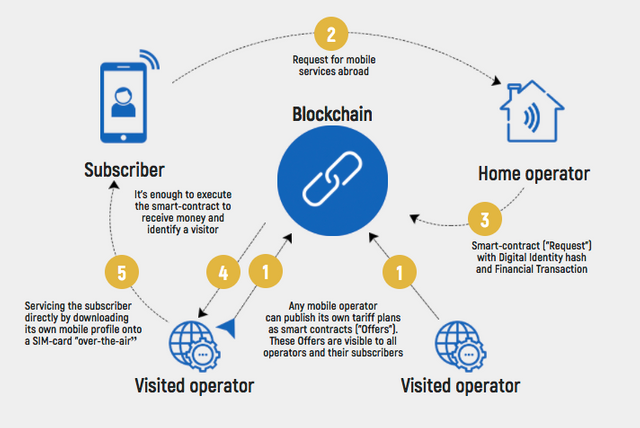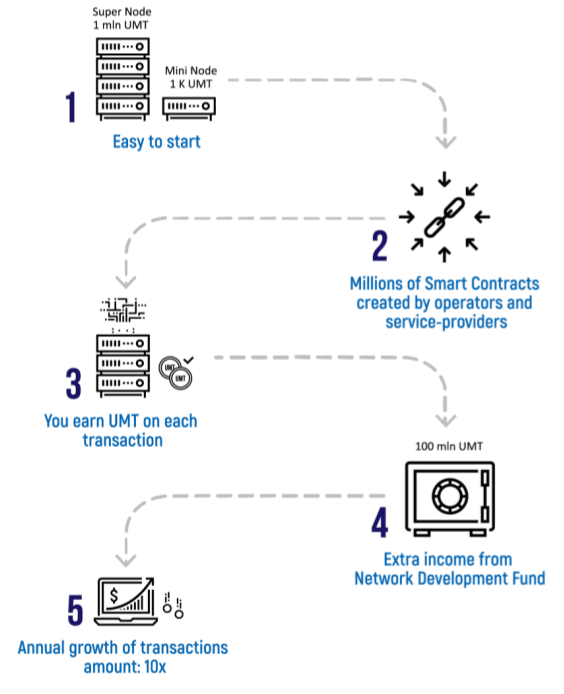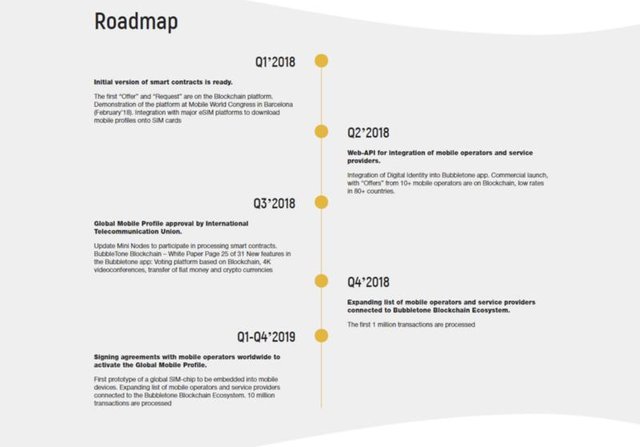
INTRODUCTION
“Blockchain in Telecom” ecosystem provides direct interaction between end-users, mobile operators and service-providers via smart contracts. It eliminates hundreds of intermediators, dramatically reduces costs of mobile services (up to 10 times while going abroad), and saves years and millions of $$ on implementation of the oldfashioned and ineffective roaming technology. How it works: any mobile carrier could publish its own prepaid tariff plans (“Offers”) as smart contracts. These Offers are visible to all other operators and their subscribers. By selecting an Offer, a new “Request” smart contract is created, with the Digital Identity of a subscriber and Payment transaction.

What are its benefits?
- Transactions are incontestable. Operations conducted in blockchain are nearly impossible to fake or hide. This factor is important both for operators and their clients.
- Data are safe. An entire blockchain is kept on many nodes within the network, in many copies, so the chance of data loss is extremely low.
- The transaction error rate is minimized, as each action is controlled by a strict code on the operators’ nodes.
- Less traffic is transmitted among operators — all interactions are now conducted via a decentralized p2p network. they have analyzed many blockchain platforms and found them not entirely suitable for the telecommunications industry, as their transaction processing speed is rather low and they don’t want to let they clients down.

Actual Problems
The technology of roaming is cumbersome, expensive and hard to implement. It bears cost on the integration of carriers, measured in years and millions of dollars. As a result, the roaming services market has become virtually monopolized by the major carriers, and it is closed to regional carriers. The latter actually lose their subscribers at a time when they are traveling abroad.One more problem is a decreasing average revenue per user because of strong competition between operators. Small and medium mobile operators have limited budgets on R&D and marketing to implement new services in short period. As a result, they are not able to compete with large mobile carriers on equal terms.
Solution
By connecting to Bubbletone Blockchain, carriers will avoid the need to enter into roaming agreements. Mobile carriers will be able to connect to Bubbletone Blockchain through a simple API (Application Programming Interface). They do not have to go through a complicated and lengthy process, as in the case of roaming.In addition, mobile carriers will be able to provide services to subscribers coming to their country with acquisition cost close to zero. According to our sources, to attract a subscriber today, regional mobile
carriers spend about 20%-30% of their LTV (Lifetime Value). Connection of new carriers to the Blockchain is carried out by the consensus of existing players, which makes the process transparent, excludes patronage, and also significantly reduces the appearance of
scammers.
Advantages
The offers will be regulated by the law of supply and demand, so technical and market
share dominance will become less important than, for instance, the quality of service. Isn’t
this the cellular communication we always wanted?
They are making communication services exponentially more affordable and are fighting
inequality. The cost to use and support our system is significantly less than what you’ll find
with other operators today.
- Transactions are incontestable. Operations conducted in blockchain are nearly impos
sible to fake or hide. This factor is important both for operators and their clients. - Data are safe. An entire blockchain is kept on many nodes within the network, in many
copies, so the chance of data loss is extremely low. - The transaction error rate is minimized, as each action is controlled by a strict code on the
operators’ nodes. - Less traffic is transmitted among operators — all interactions are now conducted via a
decentralized p2p network. - Any additional code the system runs on is void of sensitive information that could be
stolen. The only data requiring protection are the private keys of the participants.
Token Sale Process:
The pre-ICO sale starts on January 20, 2018, and it ends on February 15, 2018. The approximate value of one token is around 0.42 USD. There is 10K USD minimum. Regarding the ICO, the Crowd-sale starts on March 20, 2018, and it ends on May 20, 2018. The UMT tokens can be bought after depositing funds on the BubbleTone user accounts. Payment methods will include several cryptocurrencies, wire transfer, VISA/MC credit/debit cards. Among the available payment options are BCH, BTC, ETC, ETH, DASH, LTC, USDT, XRP as well as the Wire Transfer and Visa/MasterCard.
Token details:
- Token name: UMT
- Price 1 UMT = 0.5 USD
- Platform: Graphene
- Accepting: BTC, LTC, XRP, BCH, DASH, ETC, ETH, USDT, Fiat
- Soft cap: 10000000 USD
- Hard cap: 100000000 USD
- Country: Russia
- Whitelist/KYC: None.
Roadmap

Team


For More Information:
Website : http://bubbletone.io/
Twitter BubbleTone :http://twitter.com/bubbletone_eng
Telegram BubbleTone : http://t.me/bubbletone
White Paper : http://bubbletone.io/BubbleTone_Whitepaper_29Dec2017.pdf
Author : Quemalrs
Profile Link: https://bitcointalk.org/index.php?action=profile;u=1638981
